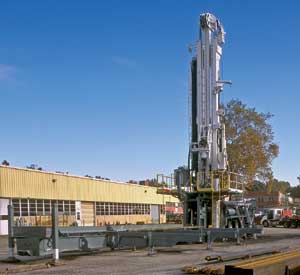| Vol. 227 No. 12 |
 |
New rig designs
Telemast Extended to TXD Rigs
Schramm’s recently-introduced Telemast tower system has been a success on two Rotadrill rig models and is now being moved up to the next size drilling rig, the TXD, for deeper drilling capabilities. Schramm introduced the first TXD unit in August.
Both smaller rig models, T90XD and T130XD, are heavy-duty, heavy-hoist, straight-truck-carrier mounted, topdrive drilling rigs. Aside from their respective 90,000-lb and 130,000-lb lift capacities, the T90XD can handle Range-II casing, while the T130XD can handle Range-III casing. All three rigs are classed as shallow oil and gas land drilling rigs suitable for CBM projects.
With a hoist rating of 180,000 lb, the TXD has a greater hoisting capacity than the T130XD or T90XD, 40% and 100% respectively. Some drilling contractors report that their T130XD rigs are drilling to 7,000 ft.
 |
Schramm’s Telemast two-section mast system includes a separate trailer (foreground) that can stow up to 40 pieces of pipe.
|
|
The Telemast is a two-section mast. Section-one is affixed at its base to the drilling rig’s chassis, while section-two is a sliding, extendable section. When in the upright position, section-two can telescope up and out of section-one, similar to the extendable mast on a forklift.
The top drilling head is attached to section-two, which is powered by two-way hydraulic cylinders for quick extension and retraction. The TXD can handle 48-ft, Range-III casing. With section-two fully extended, head travel is 50 ft.
Telemast’s compactness is a great advantage. The modest overhang feature on the T130XD makes the drilling rig simpler to transport because it clears obstructions, like telephone poles and street signs, when making a 90° turn.
While the TXD has no mast overhang, because of its semi-trailer mount, it does use a shorter trailer length that reduces the drilling rig’s footprint. The semi-trailer is pulled by a conventional road tractor fitted with a fifth wheel.
A separate, specially-designed, drillpipe and casing trailer is part of the TXD system. From this trailer, pipe and casing are automatically fed to the drillhead one-by-one to increase the drillstring’s length. It can stow up to 40 pieces of pipe.
The trailer has its own tandem-axle system for road-tractor transport. After detaching the tractor, it can be set-up for drilling by stabilizing it with outriggers.
Individual pipe or casing rests in a feeding cradle that is centered longitudinally on the trailer. Hydraulic action tilts the feeding cradle up from horizontal to a precise incline position, which aligns it with the drillhead assembly. The drillhead assembly simultaneously tilts to receive the pipe or casing. Once the two are indexed, a hydraulic-powered gripper automatically holds the pipe or casing in place, while the drillhead assembly screws it on at the rotating drive connector.
With the pipe or casing connected, the head tilts down into the drilling position as the feeding cradle returns to the horizontal position to receive another pipe or casing segment. The cradle is fed by rolling the new segment from the holding section into the feeding cradle. This rolling action is reversed when taking pipe out of the string, setting it in the feeding cradle and placing it back in the pipe storage area.
An important attribute of the automated pipe-handling system is its ability to handle random pipe sizes automatically. Any mix of different pipe lengths (up to 48 ft) can be added to the string. 
|




